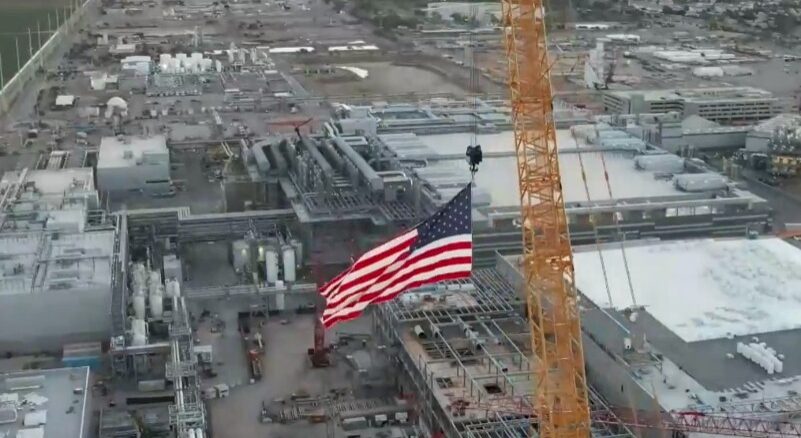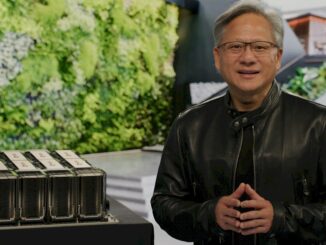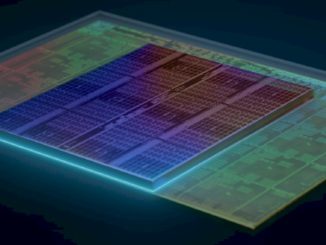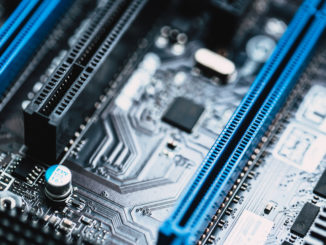
People are impatient for Intel to get fixed, and have been for many years. Weird deal after weird deal keeps coming out of the rumor mill, and now we have rumors that rival chip designer and seller Broadcom and rival chip manufacturer Taiwan Semiconductor Manufacturing Co want to cleave Intel into two, with each taking the appropriate half.
In a way, if things were a lot worse technically and financially for Intel, then the course of action by potential suitors, investors, and the US government would be swifter, more sweeping, and perhaps in the long run more effective. But Intel is limping along, making a fair amount of money on PC processors and still getting its supply wins for CPUs even as the center of gravity for revenue and profit has shifted to chips for running AI workloads. Which is why everyone, including President Trump, is trying to figure out what kind of deal can be done and who it can be done with.
As we write this, Wall Street is not yet open. Intel has a market capitalization of $102.2 billion, which given how much investment Intel needs to take on TSMC in manufacturing – call it somewhere between $50 billion and $75 billion over the next five years – seems a bit high. But we suspect that people will be enthusiastic about anything that saves Intel and preserves it in some fashion, so the stock will pop. And that is why we believe that the talk about Broadcom and TSMC each talking half of Intel – Broadcom gets Intel Products and TSMC gets Intel Foundry – is just that: A lot of talk to move the stock.
That said, talk is how all deals start, and we do think that Broadcom and TSMC have no doubt thought about just what is being rumored, just like we also believe that Qualcomm has thought about buying the Intel Products business. We have thought about all kinds of crazy things ourselves, because entertaining ideas is, well, entertaining.
None of this means an idea can come to fruition, of course.
A Kernel Of Truthiness
For the past several months since chief executive officer and presumed Intel savior Pat Gelsinger was ousted from those jobs by Intel’s board of directors, there have been all kinds of rumors about how Intel would untangle its gordian knot of making and designing chips. Alexander the Great, who famously decided that the impossibly complex original Gordian Knot could not be untied and cut the damned thing in half with his sword, would approve of the action behind these rumors.
Historical context, and an illustration of the capriciousness of people sometimes when they choose a ruler. According to legend, the people of Phrygia in Asia Minor, across the Aegean Sea from ancient Greece in what is today the central part of Turkey, were without a king. An oracle said the next person that came into the city driving an ox cart should be king, so a farmer named Gordas got the job and had the city of Gordium named after him. The ox cart was tied to a post with a rope of dogwood bark, and a new legend was created such that whoever could untie the knot would be ruler of all of Asia.
Enter Alexander in 333 BCE, a strapping lad of 23 with worldly aspirations who was named king of Macedonia three years earlier and who invaded Persia two years earlier. Facing his own Kobayashi Maru, a presumably impatient Alexander (who was also a smartass like Captain Kirk) walked up to the knot, sliced it in half with his sword, and spent the next seven years waging war until he was, indeed, ruler of a lot of western Asia as well as Greece and Egypt before he died in 323 BCE.
Gelsinger, who knew the founders of Intel, was trying to untangle the knot the chip maker has tied itself up into. The Intel board was clearly sick of waiting for the untangling. Gelsinger thought he was engineering a balanced turnaround for both Intel Products and Intel Foundry when what the board wanted was a more immediate solution to unlock shareholder value.
We think, by the way, the lack of a competitive GPU or AI accelerator, with neither the current Gaudi 3 nor the originally impending “Falcon Shores” accelerator that resulted from the convergence of the ill-fated “Ponte Vecchio” Max GPU datacenter line and the Gaudi line, is actually what sunk Gelsinger. As well as the massive investment in money and time that would be required to get Intel Foundry truly on par with TSMC, which is the dominant manufacturer of CPUs, GPUs, and other compute engines today.
Let’s pick this Broadcom-TSMC rumor apart and game theory it a bit. We will start with Intel Products.
The chip design and peddling part of Intel is in much better shape than the chip making business, and has been all through this decline. This was made all the more obvious as Intel carved out the profit and loss statement for its foundry and product groups and extracted Altera and Mobileye from the latter and sold off the flash storage business. Revenues and profits are a lot lower in the Data Center & AI group than Intel is used to, with revenues of $12.82 billion and operating income of $1.34 billion (10.4 percent of revenue), but it is not under water. It is more like treading water in the deep end under the diving board as Nvidia sits in the AI hot tub drinking champagne and AMD is playing joyfully in the HPC splash pool with an AI smoothy.
The Network & Edge group, strangely called NEX, ought to be itself carved up into two and its pieces put back into DCAI and the Client Computing Group that makes PC and edge devices that resemble them. NEX had $5.84 billion in sales last year and had $802 million in operating profits (13.7 percent of revenue). Client Computing Group is the healthiest part of the Intel Products business, with $30.29 billion in sales, mostly for desktop and laptop PC processors, with operating income of $10.92 billion last year (36.1 percent of sales). Add it all up, Intel Products had $48.95 billion and operating income of $13.06 billion, or 26.7 percent of sales.
Just for a reality check: AMD had total revenues of $28.79 billion in 2024, with $1.92 billion in operating income, which is 7.4 percent of revenue. Intel Products is nearly twice as large and nearly three times as profitable as AMD, which is roughly analogous to Intel Products as a whole. AMD has a market capitalization of $186 billion as we go to press, and we think that more than half of that market value is because it has an AI chip business whereas Intel does not really.
The Intel Foundry business is without question why Intel’s market capitalization is so low. It had $17.54 billion in revenues last year, making chips for the Intel Products business and a few smaller customers and the US government. IFS had an operating loss of $13.41 billion across 2024, and that was because IFS is ramping up its Intel 3, 18A, and 14A processes and because it is operating its foundry at much lower capacity than it ought to be doing.
It would be easy to argue that Intel Products should have a market capitalization of at least $200 billion, even without an AI compute engine, because the world still needs CPUs for PCs and servers. And that means the Intel Foundry business has a negative market capitalization. Which, by the way, IBM Microelectronics had when Big Blue “sold” it to GlobalFoundries in 2014 and which the AMD foundry also had when it “sold” it to the sovereign wealth fund of United Arab Emirates in 2008.
GlobalFoundries did not make the jump to 10 nanometer manufacturing and failed to bring 7 nanometer extreme ultraviolet (EUV) lithography to market, too. Intel had famous troubles getting to 10 nanometer and 7 nanometer processes, had issues with 5 nanometers, too, and is now ramping 3 nanometer and smaller processes after much, much grief. Samsung created a 7 nanometer process for CPU manufacturing, which is used by IBM for its Power10 and z16 processors. A modified version of the 7 nanometer process from Samsung will be used for its Power11 chip this year. The IBM z17 processor due later this year will use a Samsung 5 nanometer process. (The wonder is why Power11 will not use this same process, and we suspect it is just that IBM does not feel like it has to do that yet for its Power Systems customers.)
All of that analysis above it to bring home the point that of course Broadcom might be interested in acquiring the Intel Products business. But even Broadcom might have a little trouble coming up with the money that would be required for such a takeover.
TSMC’s motivations for acquiring Intel Foundry, or better still becoming a substantial shareholder in it, are different but no less significant.
The foundry created by Morris Chang in 1986 with backing from Philips (and snubbing from Intel and Texas Instruments), is the crown jewel of the inland nation that its name bears. And that is a big problem in a world where the United States and China are in a trade war and arguably in sequel to the Cold War that dominated 20th century geopolitics. Now, China is stronger than Russia, not the least of which because it has more people, more manufacturing, and more money. China wanted Hong Kong and took it, and it wants Taiwan and it will eventually try to take it. And after it does that, it may look east towards archrival Japan, with which it has historical scores to settle. It may look south to the two Koreas at some point, too, which would be bad for Samsung, the other big foundry in the world that has advanced processes aside from TSMC and Intel.
If this all sounds crazy, it is. But it is also deadly serious. This is what the New Colonial Age married to the New Cold War looks like. Ask Canada and Greenland.
If we were TSMC, we would be looking to build a lifeboat, and buying Intel Foundry would perhaps be the quickest way to get a footprint in chip manufacturing, with an existing and reasonably large customer base in Intel Products, within the United States, Europe, and Israel, far outside the reach of the Chinese military and not part of its aspirations.
We do not think President Trump would allow for TSMC to buy Intel outright, but he may be willing to broker a deal where TSMC is a substantial shareholder alongside a sovereign fund created by the US government to prop up the other slightly more than half of Intel Foundry. This way, the Intel name is preserved even if TSMC runs Intel Foundry for the foreseeable future.
This is not a clean and easy deal, but neither is the CHIPS Act, which hails from the Biden Administration and which compels Intel to maintain a majority stake in its foundry. The $7.86 billion that Intel got to support manufacturing expansion in its foundries in Ohio, Arizona, and other US facilities, is clearly not enough to get Intel competitive with TSMC.
The other thing to do, and what you might expect the Trump Administration to try, is to get two companies bidding on massive investments in Intel Foundry. So don’t be surprised if Samsung is suddenly part of the discussion, as well as other chip makers without advanced processes.
It would have been far easier if Intel had actually stuck to its foundry research and development in the 2010s and not got sidetracked by acquisitions that made no sense and milking CPU customers hard enough to foment the Arm insurrection in the datacenter. Perhaps there is, in fact, no way to cut this Gordian Knot and have both halves live, as weird as that sounds, without substantial investment from the US government for national security reasons.
Which brings us to the next idea. Assuming Intel gets its 18A and 14A processes up and running, we are just one executive order away from the Trump Administration compelling the likes of Nvidia, AMD, and others to use the free-standing Intel Foundry backed by TSMC and others to etch their compute engines. So that revenue stream can grow a lot faster for Intel Foundry than you think.





Intel would not survive without it fabs. Foundry cost adds minimally + 35% to + 50% of the price of a finished component. AMD pays TSMC as much as AMD’s gross take per unit on a 2-way split of any TSMC produced AMD component total revenue potential.
Intel without it fabs would end up at a cost disadvantage, a margin disadvantage, and would lose its cash cow properly managed sustaining the organizations overall monopoly bloated although right sizing cost structure currently operating at marginal revenue = marginal cost = price for every next unit of production. Currently just enough money in fabrication and packaging to produce every next unit of production to cover CapEx brown and green field fab construction, outfitting and the research and development expense.
I’ve proposed in my writings that Intel sell shares in IF to between 5 and 7 large customers that would hold board seats and participate in decision making OPERATNG Intel IF on the ‘private golf club’ model for access, starts, wafer and other materials as an operating satellite of a ‘federated’ Intel. This is a similar business model to ARM holdings plc; parent and satellite(s). Government and the US Trump executive understand federated and private golf club business models and lots of people in semi fabrication and equipment play golf.
All foundries are basically clubs (small cartels) maintained by their largest customers on material inputs block negotiation / procurement directing to downstream system design production so why not Intel and some appropriate number of charter IF fab club members? If the operation grows charter members can sell some of their shares to grow membership. If foundry fails, the value of those shares becomes another question BUT I don’t think Intel IF will fail and success sustainable well operated.
I also think the Intel + GoFlo merger a viable idea.
The January 27, 2025 regular 9341 Congressional briefing recommended State of Ohio start looking for a New Albany buyer before fab shell outfit and TSMC would not be a bad buyer for auto / industrial embedded components production. I believe Intel will never produce an Intel component in Ohio on embedded slim margin. If not TSMC there are a handful of prospect fab buyers already producing components for auto and industrial embedded so why not on that core competency?
Mike Bruzzone, Camp Marketing
TSMC acquiring Intel Foundry would essentially be a monopoly. Hopefully antitrust concerns prevent this from happening (and then con artists at Broadcom who are milking Ware customers are not allowed to purchase Intel Products either).
We may have no choice here. It might be Intel/TSMC US versus SMIC/TSMC Taipei.
Given how brilliantly destructive splitting Intel in two is likely to be, I’m surprised selling the foundry directly to SMIC isn’t one of the promoted options. That would, at least, encourage continued innovation all around.
I think it is very plausible Intel’s 18A process and the intellectual property behind it is more valuable than what either TSMC or Samsung will achieve in the coming years
On a more serious note, Solomon’s trick of threatening to cut the baby in half may yet uncover the true loving mother of economic prosperity in the United States.
I think a partnership with China is politically unpalatable at the moment. But stranger things have happened, and that can change on a whim if the Trump Administration decides co-opetition is better than war. Everything is a lever, and everything is a deal.
K.C., I agree, TSMC was pressed into the US not only for US domestic revenue generation and TSMC geographic diversification, and in Japan and Germany to fill in downstream industry regional voids but also to break up primarily a U.S. customer cartel that made TSMC a monopoly operator in Asia Pacific. Some of this is about harmonization letting China into TSMC Taiwan by freeing up capacity that otherwise would be monopolized by western incumbent component design producers. I trust TSMC can do business with China securely and vice versa for open commerce as a method for in-region conflict resolution or at least de-escalation.
On Broadcom, TSMC or others concentrating sources of fabrication procuring Intel fabs, that is why I recommend in my government briefings a JV ‘fab club’ beginning with 5 to 8 large customers operating on the ‘private golf club’ model, that would limit monopolization to a small cartel. I’m willing to give that concession because all fabs operate as small clubs of sorts on material block procurements and directing finished components to downstream design manufacture / producers and those mutual dependencies are not going to change anytime soon. Think of it as minimally level competition in the market for foundry fabrication / production.
I’m not convinced that even Gelsinger, Chandrasekaran or Holthaus, or Yeary, have done a thorough enough audit to dismiss the multi-partner fab stock-shares buy-in for access, allocation and starts. Intel 7 is obviously manufacturable, and Intel 3 Xeon showed up in the channel this week. I’d say the only reason prospect members of a fab JV would diss Intel is because of manufacturability and I don’t see that being an obstacle over the short term simply a matter of constant improvement. Having lived through Intel thefts of IP, I don’t see that as an issue today in relation the volume manufacturing question primarily on the maturity of IP protections.
I would be more concerned with the private banking system question associated fab clubs and the downstream production chain and fab accountability with design customers for accurate accounting associated third party license revenue due.
Mike Bruzzone, Camp Marketing
Another excellent article here, lovably objective and realistic!
You still remain among my most favourite editors in today’s day and age of hot-minute confusion.